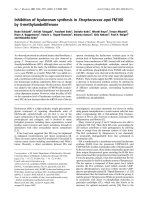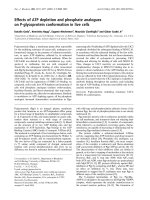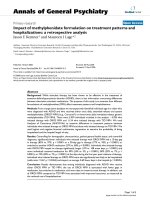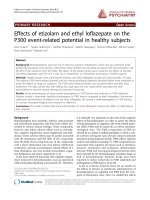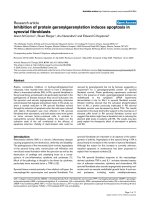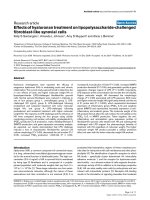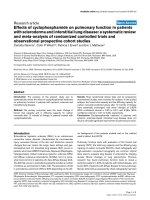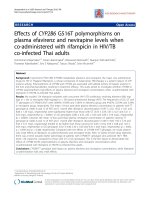Báo cáo y học: "Effects of hyaluronan treatment on lipopolysaccharide-challenged fibroblast-like synovial cell" pdf
Bạn đang xem bản rút gọn của tài liệu. Xem và tải ngay bản đầy đủ của tài liệu tại đây (815.5 KB, 11 trang )
Open Access
Available online />Page 1 of 11
(page number not for citation purposes)
Vol 9 No 1
Research article
Effects of hyaluronan treatment on lipopolysaccharide-challenged
fibroblast-like synovial cells
Kelly S Santangelo
1
, Amanda L Johnson
1
, Amy S Ruppert
2
and Alicia L Bertone
1
1
Department of Clinical Sciences, College of Veterinary Medicine, The Ohio State University, 1900 Coffey Road, Columbus OH 43210, USA
2
Center for Biostatistics, The Ohio State University, 320 West 10th Avenue, Columbus OH 43210, USA
Corresponding author: Alicia L Bertone,
Received: 3 Jun 2006 Revisions requested: 20 Jul 2006 Revisions received: 19 Dec 2006 Accepted: 10 Jan 2007 Published: 10 Jan 2007
Arthritis Research & Therapy 2007, 9:R1 (doi:10.1186/ar2104)
This article is online at: />© 2007 Santangelo et al.; licensee BioMed Central Ltd.
This is an open access article distributed under the terms of the Creative Commons Attribution License ( />),
which permits unrestricted use, distribution, and reproduction in any medium, provided the original work is properly cited.
Abstract
Numerous investigations have reported the efficacy of
exogenous hyaluronan (HA) in modulating acute and chronic
inflammation. The current study was performed to determine the
in vitro effects of lower and higher molecular weight HA on
lipopolysaccharide (LPS)-challenged fibroblast-like synovial
cells. Normal synovial fibroblasts were cultured in triplicate to
one of four groups: group 1, unchallenged; group 2, LPS-
challenged (20 ng/ml); group 3, LPS-challenged following
preteatment and sustained treatment with lower molecular
weight HA; and group 4, LPS-challenged following
pretreatment and sustained treatment with higher molecular
weight HA. The response to LPS challenge and the influence of
HA were compared among the four groups using cellular
morphology scoring, cell number, cell viability, prostaglandin E
2
(PGE
2
) production, IL-6 production, matrix metalloproteinase 3
(MMP3) production, and gene expression microarray analysis.
As expected, our results demonstrated that LPS challenge
induced a loss of characteristic fibroblast-like synovial cell
culture morphology (P < 0.05), decreased the cell number (P <
0.05), increased PGE
2
production 1,000-fold (P < 0.05),
increased IL-6 production 15-fold (P < 0.05), increased MMP3
production threefold (P < 0.05), and generated a profile of gene
expression changes typical of LPS (P < 0.005). Importantly,
LPS exposure at this concentration did not alter the cell viability.
Higher molecular weight HA decreased the morphologic
change (P < 0.05) associated with LPS exposure. Both lower
and higher molecular weight HA significantly altered a similar set
of 21 probe sets (P < 0.005), which represented decreased
expression of inflammatory genes (PGE
2
, IL-6) and catabolic
genes (MMP3) and represented increased expression of anti-
inflammatory and anabolic genes. The molecular weight of the
HA product did not affect the cell number, the cell viability or the
PGE
2
, IL-6, or MMP3 production. Taken together, the anti-
inflammatory and anticatabolic gene expression profiles of
fibroblast-like synovial cells treated with HA and subsequently
challenged with LPS support the pharmacologic benefits of
treatment with HA regardless of molecular weight. The higher
molecular weight HA product provided a cellular protective
effect not seen with the lower molecular weight HA product.
Introduction
Hyaluronan (HA), a common component of connective tissue,
is a long, unbranched nonsulfated glycosaminoglycan essen-
tial for the normal function of diarthrodial joints. The high con-
centration (2.5–4 mg/ml) of HA in synovial fluid is maintained
by lining type B fibroblasts and is composed of a polydis-
persed population with molecular weights that vary from 2 ×
10
6
to 1 × 10
7
Da [1]. These large molecules can form exten-
sive macromolecule networks, although the nature of these
associations and their orientation is not resolved [2,3]. It is
postulated that hydrophobic regions of these complexes pro-
vide sites for interactions with cell membranes and other phos-
pholipids [4]. The identification of specific receptors to which
HA binds – specifically cluster determinant 44, intercellular
adhesion molecule 1, and the receptor for hyaluronan-medi-
ated motility – on a diverse number of cells supports the phar-
macologic activity of HA in addition to its rheologic properties
[5,6]. HA can also readily enter cells by endocytosis and can
interact with intracellular proteins [7]. Receptor–HA binding
results in the stimulation of signaling cascades that moderate
DMEM-S = Dulbecco's modified Eagle medium supplemented with 10% fetal bovine serum, 29.2 mg/ml L-glutamine, 50 U penicillin/ml, and 50 U
streptomycin/ml; ELISA = enzyme-linked immunosorbent assay; HA = hyaluronan; IL = interleukin; LPS = lipopolysaccharide; MMP3 = matrix metal-
loproteinase 3; PCR = polymerase chain reaction; PGE
2
= prostaglandin E
2
; RT = reverse transcriptase; TNFα = tumor necrosis factor alpha.
Arthritis Research & Therapy Vol 9 No 1 Santangelo et al.
Page 2 of 11
(page number not for citation purposes)
cellular functions, particularly cell migration, proliferation, and
endocytosis [8,9]. The unique properties of HA are equally
important for providing nutrients to cartilage, eliminating meta-
bolic byproducts and deleterious substances from the joint
cavity, and maintaining overall joint homeostasis by inhibiting
phagocytosis, chemotaxis, scar formation, and angiogenesis
[10,11].
Proinflammatory cytokines, free radicals, and proteinases
found in pathologic conditions such as rheumatoid arthritis
and osteoarthritis can adversely affect the type B synovial cells
and lead to the synthesis of HA with abnormal molecular
weight [12]. Furthermore, HA may be directly depolymerized
by free radicals, intracellular hyaluronidases, and other glycosi-
dases found in diseased synovium [13]. The decrease in
molecular size, in combination with dilution from inflammatory
infiltration of plasma fluid and proteins in aberrant joint condi-
tions, reduces the rheologic properties of synovial fluid [14].
Viscosupplementation, a procedure in which abnormal syno-
vial fluid is removed and replaced with purified high molecular
weight HA, was developed to combat these anomalous proc-
esses [15].
Numerous in vitro investigations have reported the efficacy of
exogenous HA in modulating acute and chronic inflammation,
either by reducing cellular interactions [16], binding mitogen-
enhancing factors [17,18], or suppressing the production of
proinflammatory mediators such as IL-1β [19,20]. In vivo stud-
ies have focused on the anti-inflammatory effects [21-23] and
analgesic effects [24] of HA. Interestingly, positive clinical out-
comes can be achieved with HA of both high and very low
molecular weight [1], and studies have shown that the lubricat-
ing characteristics of HA in synovial joints are not dependent
on the HA molecular weight [25]. The effects of HA on intrac-
ellular processes may depend on the molecular weight of the
HA molecule that is interacting with receptors and promoting
stable receptor clustering but a definitive mechanism has not
been identified [26].
Lipopolysaccharide (LPS) induces characteristic and well-
defined inflammatory processes and degradation cascades in
synovial tissue in vitro [27-29] and in vivo [30,31], and
induces gene expression alterations in other articular cells in
vitro [32,33]. LPS also plays an important role as an adjuvant
in the stimulation of autoimmune arthritis in rodents [34]. To
gain a better understanding of the intracellular signaling
events triggered by HA of differing molecular weights, this
study used cellular morphology, prostaglandin E
2
(PGE
2
) pro-
duction, IL-6 production, matrix metalloproteinase 3 (MMP3)
production, and a species-specific microarray to elucidate the
global gene changes of fibroblast-like synovial cells treated
with commercial intra-articular joint supplements prior to LPS
challenge. Our goal was to identify the protective effects of HA
against LPS and to determine whether these effects were
dependent on the molecular weight of the HA administered.
We hypothesized that higher molecular weight HA would
improve the negative cellular changes associated with LPS
challenge.
Materials and methods
Animals, tissue harvest and cell culture
The study protocol as described was granted ethics approval
by The Ohio State University Institutional Animal Care and Use
Committee. Three clinically normal adult horses 8–15 years of
age were selected for the study based on normal physical and
gait evaluations. Tarsocrural joints were deemed normal on the
basis of palpation and gross observation at tissue harvest.
Synovium was collected from the dorsomedial pouch of both
tarsocrural joints and pooled within each animal after aseptic
preparation and opening of the joint. Cells were isolated and
grown in culture until >95% confluent and were subsequently
stored in a standard cryopreservation solution (10% dimethyl-
sulfoxide/90% fetal bovine serum) at -80°C as primary cul-
tures. Fibroblast-like synovial cells for each animal were
thawed, resuspended in Dulbecco's modified Eagle medium
supplemented with 10% fetal bovine serum, 29.2 mg/ml L-
glutamine, 50 U penicillin/ml, and 50 U streptomycin/ml
(DMEM-S), and were grown in monolayer under standard ster-
ile conditions until >95% confluent (~24 hours) in Cellstar
T75 flasks (Greiner Bio-One, Longwood, FL, USA). It was
anticipated that fibroblast-like synovial cells were the dominant
cell population in the cultures; no inflammatory cells were
present. All flasks appeared to have similar, if not identical, cell
populations and densities at this point.
Experimental design
Fibroblast-like synovial cells >95% confluent (day 0) were allo-
cated in triplicate to one of four groups: group 1, unchal-
lenged; group 2, LPS-challenged; group 3, LPS-challenged
following pretreatment and sustained treatment with lower (5
× 10
5
–7.5 × 10
5
Da) molecular weight HA (Bioniche Animal
Health, Pullman, WA, USA) at 10 mg/ml; and group 4, LPS-
challenged following pretreatment and sustained treatment
with higher (3 × 10
6
Da) molecular weight HA (Pfizer Animal
Health, New York, NY, USA) at 5 mg/ml.
Pretreatment with HA on day 0 was as follows: group 3
received 3 ml (equivalent to one dose) of lower molecular
weight HA diluted in 12 ml DMEM-S, and group 4 received 3
ml (equivalent to one manufacturer's recommended dose) of
higher molecular weight HA diluted in 12 ml DMEM-S. Groups
1 and 2 received 15 ml DMEM-S only.
On day 1, groups 2, 3 and 4 received a 2-hour challenge with
3 ml LPS from Escherichia coli 055:B5 (Sigma Chemical, St
Louis, MO, USA) at a concentration of 20 ng/ml followed by
three washes/dilutions with Gey's balanced salt solution and
replacement of appropriate media by group assignment. On
day 2 the media were collected and frozen at -80°C and the
cells were isolated for RNA extraction.
Available online />Page 3 of 11
(page number not for citation purposes)
Cellular morphology and cell count
Flasks were evaluated microscopically in triplicate for each
horse and for each group on days 0–2. Morphology scores for
the fibroblast-like synovial cells were assigned at three random
locations throughout the center of the culture flasks at four
specific time points: day 0, before the initial product applica-
tion; day 1, prior to LPS challenge; day 1, immediately follow-
ing 2-hour LPS challenge; and day 2, immediately prior to cell
collection. Morphology scores were assigned based on the
following scale: 0, >95% attached with healthy fibroblastic
morphology; 1, 5–25% rounded and detached; 2, 26–50%
rounded and detached; 3, 51–75% rounded and detached;
and 4, >76% rounded and detached.
Enzyme-linked immunosorbent assays
The concentrations of PGE
2
, IL-6, and MMP3 in cell culture
media from each horse at day 2 were determined using com-
mercial competitive ELISAs (R&D Systems, Minneapolis, MN,
USA). All assays were performed according to the manufac-
turer's protocols. The optical density of each sample was read
by the Ultra Microplate Reader EL808 (Bio-Tek Instruments,
Winooski, VT, USA) and expressed as picograms per milliliter.
Prior to running the experimental samples, it was confirmed
that neither HA product significantly interfered with the activity
of the assays. Briefly, two sets of standards were created: the
first was made using standards as described by the manufac-
turer's protocol, and the second was made using these same
standards following the addition of the appropriate HA prod-
uct (at concentrations described above). The resulting optical
densities were compared using a paired t-test analysis and no
significant difference was detected.
Microarray analysis
Total RNA was isolated from the remaining cell pellet using the
phenol–chloroform extraction technique (Invitrogen, Carlsbad,
CA, USA) as described by the manufacturer's protocol. RNA
of the highest quality from each animal and from each treat-
ment group was used for species-specific microarray analysis.
Sample concentration and purity were measured by use of UV
spectra (260 nm and 280 nm) and were confirmed using the
Agilent 2100 Bioanalyzer (Agilent Technologies, Palo Alto,
CA, USA). All protocols were conducted in accordance with
the manufacturer's instructions (Affymetrix, Santa Clara, CA,
USA). For processing, total RNA (5 μg) was reverse tran-
scribed into double-stranded cDNA using RT/polymerase and
the T7-(dT)24 primer. Biotinylated cRNA was synthesized by
in vitro transcription and the cRNA products were fragmented
prior to hybridization overnight at 45°C for 16 hours on an
equine-specific gene expression microarray representing
3,098 unique genes, all of which have been annotated [35].
Microarrays were washed at low-stringent and high-stringent
conditions and were stained with streptavidin–phycoerythrin
in accordance with established protocol. The microarray
design (accession number A-AFFY-81) and the experiment
submission (accession number E-MEXP-940) are available
online in EBI's ArrayExpress public repository [36].
Validation of microarray by real-time RT-PCR
Fibroblast-like synovial cells from three individual horses were
grown under cell culture conditions as described above until
they were >95% confluent. At this point, individual culture
flasks from each horse were exposed to Gey's Balanced Salt
Solution (unchallenged control), 100 ng/ml LPS, or 1,000 ng/
ml LPS for 2 hours. Cells were immediately collected for RNA
extraction as described above; total RNA from each horse was
pooled within each of the three treatment groups. Microarray
analysis proceeded as previously described. PCR primers for
three genes expected to have great, modest, and minimal
responses to LPS challenge based on previous work [35] (IL-
1α, TNFα, and prostaglandin peroxide synthase, respectively)
were designed for real-time RT-PCR using the Primer Express
Software (Applied Biosystems, Foster City, CA, USA). Two-
step RT-PCR using the SYBR
®
Green PCR Master Mix was
performed according to the manufacturer's protocol and uni-
versal thermal cycling parameters (Applied Biosystems). Care
was taken to ensure that DNA contamination was not present
in the samples. The fold changes of each gene for each LPS-
challenged group were calculated relative to the unchallenged
control.
Statistical analyses
Objective and scored data were compared using two-way
analysis of variance followed by pair-wise comparisons with a
Bonferroni correction. Repeated-measures analysis was per-
formed on the cell counts and the cell morphology data. Sta-
tistical significance was set at α = 0.05. Microarray data were
analyzed using dChip version 1.3 [37] (Harvard University,
Cambridge, MA, USA). Array normalization was performed
using the invariant set procedure; model-based expression
indices were computed using only perfect-match probes.
Probe-set level data identified as array outliers by dChip were
omitted and considered missing data in subsequent analyses.
The model-based expression indices values were then
exported to BRB ArrayTools version 3.2.3 for further analysis
(National Cancer Institute, Bethesda, MD, USA).
Paired t tests compared gene expression between the unchal-
lenged control group (group 1) and the LPS-challenged con-
trol group (group 2). A two-way analysis of variance compared
gene expression among the LPS-challenged control group
(group 2) and the two HA-treated groups (groups 3 and 4),
blocking on the horse. For the probe sets showing differential
expression among the three LPS-challenged groups (P <
0.005), pair-wise comparisons were performed and P values
were adjusted by Holm's method. All tests involving gene
expression data used a random variance model [38]. The sta-
tistical analyses for the microarray data as described above
are included in the experiment submission available online in
ArrayExpress [36].
Arthritis Research & Therapy Vol 9 No 1 Santangelo et al.
Page 4 of 11
(page number not for citation purposes)
Results
Cellular morphology, viability, and count
The LPS-challenged control group (group 2) and the lower
molecular weight HA-treated group (group 3) had significantly
greater morphology scores than the unchallenged control
group (group 1) or the higher molecular weight HA-treated
group (group 4) (P < 0.05; Table 1). Morphologic changes in
groups 2 and 3 included reversible loss of cell attachment to
the culture flask and cell contraction (Figure 1).
Cell viability was high in all groups and no difference was
found among the groups (Table 1), indicating that 20 ng/ml
LPS did not kill a significant number of cells. Cell counts in the
LPS-challenged groups 2, 3, and 4 were significantly lower
than those of the unchallenged control group (group 1) (P <
0.05; Table 1).
Prostaglandin E
2
, IL-6, and MMP3 ELISAs
Expression of inflammatory products, particularly PGE
2
, was
anticipated to increase in response to LPS challenge [39-41].
As expected, there was a greater than 1,000-fold increase in
the PGE
2
concentration in the cell culture media of groups 2,
3, and 4 compared with that in group 1 (P < 0.05). There was
also a significant difference between the concentrations of
PGE
2
produced by groups 3 and 4 relative to group 2 (P <
0.05; Table 2). There was not a significant difference in PGE
2
production between groups 3 and 4.
Two genes, IL-6 and MMP3, were common to the two sepa-
rate gene expression analyses described below (see Gene
expression profiling). Commercial competitive ELISAs were
performed to confirm the trends seen with the microarray data.
For both genes, protein levels in group 2 were greater than
those in groups 1, 3, and 4 (P < 0.01). There was no statistical
difference in protein levels among groups 1, 3, and 4 (Table 2).
Microarray validation by real-time RT-PCR
Consistent and comparable fold changes in gene expression
were found between the microarray data and real-time RT-
PCR for the three genes of interest (Table 3).
Gene expression profiling
A comparison of all probe sets on the microarray between
groups 1 and 2 showed that 20 ng/ml LPS significantly alerted
the expression of 81 probe sets (P < 0.005; Table 4). Sixty-
one probe sets were differentially expressed among the LPS-
challenged groups 2, 3, and 4 (P < 0.005; Figure 2). Subse-
quent pair-wise comparisons of these 61 probe sets were per-
formed between groups 2 and 3 and between groups 2 and
4; a total of 19 genes represented by 21 probe sets (11 genes
and 17 genes, respectively) were differentially expressed
(adjusted P < 0.005; Table 5). No significant differences in
gene expression were found between groups 3 and 4 for
these 61 probe sets.
Discussion
Our study focused on elucidating the in vitro effects of HA of
differing molecular weights on fibroblast-like synovial cells in
the face of a LPS challenge. Notably, the higher molecular
weight HA product significantly reduced the morphologic
change of synovial cells in vitro following a 2-hour challenge
with 20 ng/ml LPS when compared with the lower molecular
weight HA product (Table 1 and Figure 1). Higher molecular
weight HA may preserve normal/healthy cell morphology due
to a number of factors. Our results suggested that one proba-
ble mechanism to explain this finding is related to the ability of
higher molecular weight HA to maintain hysteresis, compli-
ance, and fluid exchange by reducing or dissipating stress
associated with mechanical forces [42]. This facility may have
enabled the fibroblast-like synovial cells in group 4 to resist
contraction from the cell culture flasks when reacting to the
cellular effects induced by LPS. It is also possible that pre-
treatment with the higher molecular weight HA product stimu-
lated receptor-mediated intracellular signaling events that
were not potentiated to the same degree by the lower molec-
ular weight HA product in the presence of LPS [18,43,44]. It
is worthwhile to note that a larger number of genes were sta-
tistically significantly altered by the higher molecular weight
HA product (17 genes) than the lower molecular weight prod-
uct (11 genes), and the degree of significance of given gene
expression compared with LPS control was greater (that is,
Table 1
Microscopic variables for fibroblast-like synovial cells
Day 1 (pre-lipopolysaccharide challenge) Day 1 (post-lipopolysaccharide challenge) Day 2
Group 1 Group 2 Group 3 Group 4 Group 1 Group 2 Group 3 Group 4 Group 1 Group 2 Group 3 Group 4
Cellular morphology
(median and range)
0 (0-0) 0 (0-0) 0 (0-0) 0 (0-0) 0 (0-0) 3
a
(0–4) 4
a
(3–4) 1 (0–4) 0 (0-0) 3
b
(0–4) 4
b
(3–4) 0 (0–4)
Cell count (10
4
) (mean ±
SEM)
20 20 20 20 - - - - 118
c
± 33 46 ± 3 32 ± 1 49 ± 7
Cell viability (%) (mean ±
SEM)
97 ± 0.396 ± 1.294 ± 2.696 ± 0.1
Triplicate samples were performed for each of the three individual donors in the four groups. Group 1, unchallenged control; group 2,
lipopolysaccharide control; group 3, pretreatment and sustained treatment with lower molecular weight hyaluronan product; group 4, pretreatment
and sustained treatment with higher molecular weight hyaluronan product. 0, >95% attached; 1, 5–25% detached; 2, 26–50% detached; 3, 51–
75% detached; 4, >76% detached. SEM, standard error of the mean; -, values not determined.
a,b,c
Significant difference exists (P < 0.05).
Available online />Page 5 of 11
(page number not for citation purposes)
Figure 1
Representative microscopic images of fibroblast-like synovial cells post-lipopolysaccharide challengeRepresentative microscopic images of fibroblast-like synovial cells post-lipopolysaccharide challenge. Representative microscopic images (400×
magnification) of fibroblast-like synovial cells (a), (c), and (e) 2 hours post-lipopolysaccharide (LPS) challenge and (b), (d), and (f) 24 hours post-
LPS challenge. Cells treated with the higher molecular weight hyaluronan (HA) product (group 4, pretreatment and sustained treatment with higher
molecular weight HA) were protected from (d) and (e) the morphologic changes induced by LPS, including the loss of cell attachment to the culture
flask and the pronounced cellular contraction that were seen in (a), (b) group 2 (LPS control) and (c), (d) group 3 (preteatment and sustained treat-
ment with lower molecular weight HA).
Arthritis Research & Therapy Vol 9 No 1 Santangelo et al.
Page 6 of 11
(page number not for citation purposes)
lower P values) with the higher molecular weight product. This
is a less probable explanation, however, as no statistical differ-
ence in gene signaling was found between groups exposed to
lower or higher molecular weight HA.
Other reported potential mechanisms were less supported by
our data. For example, higher molecular weight HA can be
more effective than lower molecular weight HA products at
binding inflammatory mediators or corresponding receptors,
including LPS itself and soluble agents released from chal-
lenged cells, thereby inhibiting their activity [17,39]. In partic-
ular, HA can protect surface-active phospholipids, the major
boundary lubricant in joints, from lysis by phospholipase A
2
[45]. Furthermore, it could be suggested that the higher
molecular weight HA product maintained a greater degree of
protection from LPS by creating an inert physical barrier not
adequately provided by lower molecular weight HA. Apprecia-
bly, the comparable cell counts, PGE
2
concentrations, and
gene expression alterations of the LPS-challenged groups 3
and 4 dispute both of these theories. These results indicated
that higher molecular weight HA was involved in a dynamic
interaction that neither completely prevented LPS from
accessing the fibroblast-like synovial cells nor bound all avail-
able LPS. Additional experimentation is warranted to fully
define the mechanism behind the apparent protective effect of
higher molecular weight HA relative to lower molecular weight
HA upon challenge with LPS.
The gene expression profile generated by LPS challenge in
this study (Table 3) was consistent with published data [35].
Addition of LPS at a concentration of 20 ng/ml induced differ-
ential expression of several genes, particularly TNFα, chon-
droitin sulfate proteoglycan, prostaglandin G/H synthase-2,
MMP3, HA synthase 2, and IL-6. It was anticipated that there
would be a reduction in the number of genes significantly
altered by this concentration of LPS relative to the gene profile
previously reported for 100 ng/ml by Gu and Bertone [35].
The similarity in expression profiles between the two HA-
treated groups 3 and 4 suggested that differing molecular
weights, within a certain range and concentration, may not be
integral for initiation of intracellular signaling. The pharmaco-
logic benefits of pretreatment and sustained treatment with
exogenous HA were supported by the difference in gene
expression profiles between the LPS-challenged group 2 and
Table 2
Mean concentrations of prostaglandin E
2
, IL-6, and matrix metalloproteinase 3 in culture media of fibroblast-like synovial cells
determined by ELISAs
Group 1 Group 2 Group 3 Group 4
Prostaglandin E
2
(pg/ml) 15.43 ± 15.43 21,025
a
± 6,828 2,998
b
± 887 2925
b
± 1,669
IL-6 (pg/ml) 1.77 ± 1.74 41.33
c
± 16.18 9.49 ± 3.53 6.79 ± 3.11
Matrix metalloproteinase 3
(pg/ml)
2.60 ± 1.36 6.31
d
± 0.26 2.96 ± 1.08 1.80 ± 0.90
Data presented as the mean ± standard error of the mean. Triplicate samples were performed for each of the three individual donors in the four
groups. Group 1, unchallenged control; group 2, lipopolysaccharide control; group 3, pretreatment and sustained treatment with lower molecular
weight hyaluronan product; group 4, pretreatment and sustained treatment with higher molecular weight hyaluronan product.
a,b
Significant
difference exists (P < 0.05).
c,d
Significant difference exists (P < 0.01).
Table 3
Comparison of the fold changes between species-specific microarray analysis and real-time RT-PCR performed on fibroblast-like
synovial cells exposed to lipopolysaccharide
Fold change after 100 ng/ml
lipopolysaccharide challenge
Fold change after 1,000 ng/ml
lipopolysaccharide challenge
Real-time RT-PCR primer
Microarray analysis Real-time RT-PCR Microarray analysis Real-time RT-PCR
IL-1α 16 155 34 290 Forward, TTGTGCCAACCAATGAGATCA
Reverse, TTCATGCTTTGCCTTCTTCTTG
TNFα 5 6 6 10 Forward,
GACTTGAAGTTTTCTAAGCGATGCT
Reverse, GGATCCACTGCCACGTACTTG
Prostaglandin peroxide synthase 3 2 3 4 Forward, GGCCAGTTTTCCTCACCAAA
Reverse,
AAATAAAGCTCTCTGCTTTTCATGAA
The fold changes are normalized to unchallenged fibroblast-like synovial cells.
Available online />Page 7 of 11
(page number not for citation purposes)
the HA treatment groups 3 and 4. The majority of genes that
were differentially expressed between the LPS-challenged
control group and the two HA treatment groups are well-rec-
ognized gene products involved with inflammatory conditions
of the joint, particularly rheumatoid arthritis (Table 4)
[40,41,46-53]. Additionally, we found a decrease in produc-
tion of the inflammatory mediator PGE
2
in groups 3 and 4, pro-
viding further evidence of an anti-inflammatory effect of HA.
Interestingly, only two genes (IL-6 and MMP3) that were sig-
nificantly increased in gene expression by LPS relative to the
unchallenged control were significantly decreased in expres-
sion by the addition of HA, regardless of molecular weight
(Tables 3 and 4). Other inflammatory mediators that were
increased in gene expression by LPS, including TNFα, were
not altered in either of the two HA treatment groups. In con-
cert, these data suggested that pretreatment with a HA prod-
uct resulted in a completely different and potentially beneficial
gene expression profile when compared with the control
groups. It is striking that treatment with HA shifted the gene
expression profiles in an anti-inflammatory and anticatabolic
direction relative to the LPS-challenged control group. Our
data suggest that pretreatment and sustained exposure for 48
hours to HA may repress the molecular signaling of LPS by ini-
tiating independent intracellular events.
The limitations of this in vitro study with relevance to clinical
application of intra-articular HA therapy are recognized. The
fibroblast-like synovial cells used in this study are the largest
proportion of cells found in the synovium, but are not the only
component. The presence of other tissues in the joint will influ-
ence the effect of HA on overall joint homeostasis in vivo. In
addition, the fibroblast-like synovial cells in this study were
raised in either an environment devoid of HA (control groups 1
and 2) or in a stable environment containing HA (groups 3 and
4). This permitted a controlled evaluation of the influence of
HA but did not mimic the in vivo environment of a joint, where
synovial fluid is neither free of HA nor does supplemented HA
permanently remain in the articular space. Future in vivo stud-
ies would provide important information on HA as an intra-
articular therapy.
Although the mechanism of action of LPS in antibody-induced
arthritis remains uncertain, its role in joint inflammation and
arthritis pathogenesis is well recognized [29]. As such, our
study using LPS provided further in vitro evidence that pre-
emptive and early viscosupplementation with HA is a viable
and potentially valuable treatment option for inflammatory syn-
ovitis and rheumatoid arthritis [54-56].
Table 4
Select/relevant genes with significant differential gene expression between the lipopolysaccharide-challenged control group and
the unchallenged control group
Genbank accession number Equine gene Fold change (group 2/group 1) P value
AY114351 Granulocyte chemotactic protein
2
10.0 <0.0001
CD528275
Interferon-induced protein 0.03 <0.0001
CD468799
GRO3 oncogene 10.0 <0.0001
BI960809
TNFα 2.5 0.0001
AJ251189
Chemoattractant protein-1 3.33 0.0016
CD536631
GRO2 oncogene 10.0 0.0002
BM734848
Chondroitin sulfate proteoglycan
2
2.0 0.0005
AB035518
Adrenomullin 0.42 0.0006
AF230359
Urokinase plasminogen activator
receptor
1.67 0.0009
AF053497
Melanoma growth stimulatory
activity homolog
5.0 0.0014
AF027335
Prostaglandin G/H synthase-2 3.33 0.0021
U62529
Matrix metalloproteinase 3 2.0 0.0026
CD467591
Heat shock protein 70 2.5 0.0027
AY056582
Hyaluronic acid synthase 2 5.0 0.0028
U64794
IL-6 2.0 0.0037
Three individual donors are represented for each group. Group 1, unchallenged control; group 2, lipopolysaccharide-challenged control.
Arthritis Research & Therapy Vol 9 No 1 Santangelo et al.
Page 8 of 11
(page number not for citation purposes)
Conclusion
The anti-inflammatory and anticatabolic gene expression pro-
files of synovial cells treated with HA and subsequently chal-
lenged with LPS supports the pharmacologic benefits of
treatment with HA regardless of molecular weight. The higher
molecular weight HA product provided a cellular protective
effect not seen with the lower molecular weight HA product.
Competing interests
The authors declare that this study was funded, in part, by
Pfizer Animal Health, Inc.
Authors' contributions
KSS performed the cell culture work, the ELISAs, and some
RNA extractions, and drafted the manuscript. ALJ performed
the majority of the RNA extractions. ASR contributed to the
statistics involved in the gene expression analysis. ALB con-
ceived of and coordinated the study, edited the manuscript,
and obtained funding for the project. All authors read and
approved the final manuscript.
Figure 2
Sixty-one probe sets differentially expressed (P < 0.005) among the lipopolysaccharide-challenged groupsSixty-one probe sets differentially expressed (P < 0.005) among the lipopolysaccharide-challenged groups. Three individual donors are represented
for each group. Group 2 (G2), LPS control; group 3 (G3), pretreatment and sustained treatment with lower molecular weight hyaluronan (HA) prod-
uct; group 4 (G4), pretreatment and sustained treatment with higher molecular weight HA product. Columns represent individual animals 1, 2, and
3. Rows represent probe sets ordered by a hierarchical cluster analysis using the average linkage and 1 – Pearson correlation as the measure of dis-
similarity. Shading is indicative of relative expression: white, median expression; deepening shades of red, increasing expression of the probe set
above the median value; deepening shades of blue, decreasing expression of the probe set below the median value. *Gene expression differentially
expressed (adjusted P < 0.005) between at least one of the pairs of treatments.
†
Probe set found in canines, which was included on the microarray
to validate data.
Available online />Page 9 of 11
(page number not for citation purposes)
Table 5
Genes significantly upregulated or downregulated in lipopolysaccharide-challenged groups 2, 3, and 4
Full or provisional gene annotation
(accession number)
Function or activity in joint
inflammation
a
Fold change Pair-wise comparisons (adjusted P values)
Group 3/group 2 Group 4/group 2 Group 3 vs group 2 Group 4 vs group 2
IL-6 (U64794) Proinflammatory mediator [46] 0.45 0.34 0.0015 0.0015
Matrix metalloproteinase 13
(AF034087)
Connective tissue structure and
remodeling [40]
0.10 0.11 0.0039 0.0005
Cathepsin S (CD468903) Proteolysis and matrix degradation
[47]
0.47 0.57 0.0022 0.0005
Manganese superoxide dismutase
(BM734930)
Antioxidant [48] 0.62 0.71 0.0040 0.0040
Manganese superoxide dismutase
(BI960803)
0.50 0.64 0.0117 0.0024
Matrix metalloproteinase 1
(AF148882)
Connective tissue structure and
remodeling [40]
0.32 0.35 0.0050 0.0003
Matrix metalloproteinase 3 (U62529) Connective tissue structure and
remodeling [40]
0.24 0.19 0.0035 0.0051
Guanine nucleotide binding protein
alpha inhibiting 1 (CD465125)
G-protein signaling, adenylate cyclase
inhibitor [49]
0.62 0.66 0.0079 0.0046
V-maf oncogene (BM735497) Unknown 0.60 0.59 0.0035 0.0095
Inhibitor of DNA binding 2 dominant
negative helix–loop–helix protein
(CD536136)
Positive regulation of cell proliferation
[50]
0.60 0.66 0.0172 0.0038
Plasminogen activator inhibitor 1
(BM780455)
Inhibitor of proteolytic activity in
rheumatoid arthritis [51,52]
2.93 2.59 0.0002 <0.0001
Plasminogen activator inhibitor 1
(AF508034)
2.11 2.15 0.0025 <0.0001
hnRNP core protein A1 (CD469785) Target of antinuclear autoimmunity in
rheumatoid arthritis [41]
1.41 1.40 0.0114 0.0028
Aurora-A kinase interacting protein 1
(BM735310)
Positive regulator of proteolysis 1.31 1.35 0.0215 0.0044
Dyskerin (CD536222) RNA binding, processing, and
modification
2.30 1.74 0.0046 0.0028
Cyclin D
2
(CD467520) Induced by type I interferons after
lipopolysaccharide exposure; cell cycle
regulation
1.24 1.50 0.0500 0.0020
Isoleucine tRNA synthetase
(CD535292)
Isoleucyl-rRNA aminocylation 1.36 1.50 0.0254 0.0015
Nuclear ubiquitous casein kinase 2
(CD535471)
Kinase in NF-κB cascade [53] 1.62 1.55 0.0294 0.0048
Eukaryotic translation initiation factor 5
(BM781180)
Translation initiation factor 1.95 1.33 0.0048 0.0050
Eukaryotic translation initiation factor 5
(CD465311)
2.26 1.55 0.0146 0.0013
Unknown (BM780356) Unknown 1.28 1.55 0.0316 0.0011
Three individual donors are represented for each group.
a
Based on the Gene Ontology Database description and the literature (see references).
Statistically significant P values are in bold. Group 2, lipopolysaccharide control; group 3, pretreatment and sustained treatment with lower
molecular weight hyaluronan product; group 4, pretreatment and sustained treatment with higher molecular weight hyaluronan product.
Arthritis Research & Therapy Vol 9 No 1 Santangelo et al.
Page 10 of 11
(page number not for citation purposes)
Acknowledgements
The authors thank Dr Michael Radmacher for microarray analysis,
Megan Cartwright for technical assistance, Timothy Vojt for photo-
graphic support, and Dr Terri Zachos for review of the manuscript. This
study was funded, in part, by Pfizer Animal Health, Inc.
References
1. Fraser JR, Laurent TC, Laurent UB: Hyaluronan: its nature, distri-
bution, functions and turnover. J Intern Med 1997, 242:27-33.
2. Lapcik L Jr and L, Lapcik L, De Smedt S, Demeester J, Chabrecek
P: Hyaluronan: preparation, structure, properties, and
applications. Chem Rev 1998, 98:2663-2684.
3. Scott JE, Cummings C, Brass A, Chen Y: Secondary and tertiary
structures of hyaluronan in aqueous solution, investigated by
rotary shadowing-electron microscopy and computer simula-
tion. Hyaluronan is a very efficient network-forming polymer.
Biochem J 1991, 274:699-705.
4. Pasquali-Ronchetti I, Quaglino D, Mori G, Bacchelli B, Ghosh P:
Hyaluronan-phospholipid interactions. J Struct Biol 1997,
120:1-10.
5. Savani RC, Cao G, Pooler PM, Zaman A, Zhou Z, DeLisser HM:
Differential involvement of the hyaluronan (HA) receptors
CD44 and receptor for HA-mediated motility in endothelial cell
function and angiogenesis. J Biol Chem 2001,
276:36770-36778.
6. Entwistle J, Hall CL, Turley EA: HA receptors: regulators of sig-
nalling to the cytoskeleton. J Cell Biochem 1996, 61:569-577.
7. Tammi R, Rilla K, Pienimaki JP, MacCallum DK, Hogg M, Luukko-
nen M, Hascall VC, Tammi M: Hyaluronan enters keratinocytes
by a novel endocytic route for catabolism. J Biol Chem 2001,
276:35111-35122.
8. Kobayashi H, Terao T: Hyaluronic acid-specific regulation of
cytokines by human uterine fibroblasts. Am J Physiol 1997,
273:C1151-C1159.
9. Oertli B, Beck-Schimmer B, Fan X, Wuthrich RP: Mechanisms of
hyaluronan-induced up-regulation of ICAM-1 and VCAM-1
expression by murine kidney tubular epithelial cells: hyaluro-
nan triggers cell adhesion molecule expression through a
mechanism involving activation of nuclear factor-kappa B and
activating protein-1. J Immunol 1998, 161:3431-3437.
10. Forrester JV, Balazs EA: Inhibition of phagocytosis by high
molecular weight hyaluronate. Immunology 1980, 40:435-446.
11. Olutoye OO, Barone EJ, Yager DR, Uchida T, Cohen IK, Diegel-
mann RF: Hyaluronic acid inhibits fetal platelet function: impli-
cations in scarless healing. J Pediatr Surg 1997,
32:1037-1040.
12. Dahl LB, Dahl IM, Engstrom-Laurent A, Granath K: Concentration
and molecular weight of sodium hyaluronate in synovial fluid
from patients with rheumatoid arthritis and other
arthropathies. Ann Rheum Dis 1985, 44:817-822.
13. Greenwald RA: Oxygen radicals, inflammation, and arthritis:
pathophysiological considerations and implications for
treatment. Semin Arthritis Rheum 1991, 20:219-240.
14. Bothner H, Wik O: Rheology of hyaluronate. Acta Otolaryngol
Suppl 1987, 442:25-30.
15. Balazs EA, Denlinger JL: Viscosupplementation: a new concept
in the treatment of osteoarthritis. J Rheumatol Suppl 1993,
39:3-9.
16. Forrester JV, Wilkinson PC: Inhibition of leukocyte locomotion
by hyaluronic acid. J Cell Sci 1981, 48:315-331.
17. Presti D, Scott JE: Hyaluronan-mediated protective effect
against cell damage caused by enzymatically produced
hydroxyl (OH
.
) radicals is dependent on hyaluronan molecular
mass. Cell Biochem Funct 1994, 12:281-288.
18. Tobetto K, Nakai K, Akatsuka M, Yasui T, Ando T, Hirano S: Inhib-
itory effects of hyaluronan on neutrophil-mediated cartilage
degradation. Connect Tissue Res 1993, 29:181-190.
19. Nawrat P, Surazynski A, Karna E, Palka JA: The effect of
hyaluronic acid on interleukin-1-induced deregulation of colla-
gen metabolism in cultured human skin fibroblasts. Pharma-
col Res 2005, 51:473-477.
20. Sasaki A, Sasaki K, Konttinen YT, Santavirta S, Takahara M, Takei
H, Ogino T, Takagi M: Hyaluronate inhibits the interleukin-1β-
induced expression of matrix metalloproteinase (MMP)-1 and
MMP-3 in human synovial cells. Tohoku J Exp Med 2004,
204:99-107.
21. Ialenti A, Di Rosa M: Hyaluronic acid modulates acute and
chronic inflammation. Agents Actions 1994, 43:44-47.
22. Wobig M, Bach G, Beks P, Dickhut A, Runzheimer J, Schwieger
G, Vetter G, Balazs E: The role of elastoviscosity in the efficacy
of viscosupplementation for osteoarthritis of the knee: a com-
parison of hylan G-F 20 and a lower-molecular-weight
hyaluronan. Clin Ther 1999, 21:1549-1562.
23. Roth A, Mollenhauer J, Wagner A, Fuhrmann R, Straub A, Ven-
brocks RA, Petrow P, Brauer R, Schubert H, Ozegowski J, et al.:
Intra-articular injections of high-molecular-weight hyaluronic
acid have biphasic effects on joint inflammation and destruc-
tion in rat antigen-induced arthritis. Arthritis Res Ther 2005,
7:R677-R686.
24. Gotoh S, Onaya J, Abe M, Miyazaki K, Hamai A, Horie K, Tokuyasu
K: Effects of the molecular weight of hyaluronic acid and its
action mechanisms on experimental joint pain in rats. Ann
Rheum Dis 1993, 52:817-822.
25. Mabuchi K, Obara T, Ikegami K, Yamaguchi T, Kanayama T: Molec-
ular weight independence of the effect of additive hyaluronic
acid on the lubricating characteristics in synovial joints with
experimental deterioration. Clin Biomech (Bristol, Avon) 1999,
14:352-356.
26. Ohkawara Y, Tamura G, Iwasaki T, Tanaka A, Kikuchi T, Shirato K:
Activation and transforming growth factor-beta production in
eosinophils by hyaluronan.
Am J Respir Cell Mol Biol 2000,
23:444-451.
27. Moses VS, Hardy J, Bertone AL, Weisbrode SE: Effects of anti-
inflammatory drugs on lipopolysaccharide-challenged and -
unchallenged equine synovial explants. Am J Vet Res 2001,
62:54-60.
28. Frean SP, Lees P: Effects of polysulfated glycosaminoglycan
and hyaluronan on prostaglandin E
2
production by cultured
equine synoviocytes. Am J Vet Res 2000, 61:499-505.
29. Lee EK, Kang SM, Paik DJ, Kim JM, Youn J: Essential roles of
Toll-like receptor-4 signaling in arthritis induced by type II col-
lagen antibody and LPS. Int Immunol 2005, 17:325-333.
30. Palmer JL, Bertone AL, Malemud CJ, Mansour J: Biochemical and
biomechanical alterations in equine articular cartilage follow-
ing an experimentally-induced synovitis. Osteoarthritis
Cartilage 1996, 4:127-137.
31. Palmer JL, Bertone AL: Experimentally-induced synovitis as a
model for acute synovitis in the horse. Equine Vet J 1994,
26:492-495.
32. Byron CR, Orth MW, Venta PJ, Lloyd JW, Caron JP: Influence of
glucosamine on matrix metalloproteinase expression and
activity in lipopolysaccharide-stimulated equine chondrocytes.
Am J Vet Res 2003, 64:666-671.
33. Mathy-Hartert M, Martin G, Devel P, Deby-Dupont G, Pujol JP,
Reginster JY, Henrotin Y: Reactive oxygen species downregu-
late the expression of pro-inflammatory genes by human
chondrocytes. Inflamm Res 2003, 52:111-118.
34. Yoshino S, Sasatomi E, Ohsawa M: Bacterial lipopolysaccharide
acts as an adjuvant to induce autoimmune arthritis in mice.
Immunology 2000, 99:607-614.
35. Gu W, Bertone AL: Generation and performance of an equine-
specific large-scale gene expression microarray. Am J Vet Res
2004, 65:1664-1673.
36. EBI's ArrayExpress [ />]
37. Zhong S, Li C, Wong WH: ChipInfo: software for extracting
gene annotation and gene ontology information for microarray
analysis. Nucleic Acids Res 2003, 31:3483-3486.
38. Wright GW, Simon RM: A random variance model for detection
of differential gene expression in small microarray
experiments. Bioinformatics 2003, 19:2448-2455.
39. Neumann A, Schinzel R, Palm D, Riederer P, Munch G: High
molecular weight hyaluronic acid inhibits advanced glycation
endproduct-induced NF-kappaB activation and cytokine
expression. FEBS Lett 1999, 453:283-287.
40. Burrage PS, Mix KS, Brinckerhoff CE: Matrix metalloproteinases:
role in arthritis. Front Biosci 2006, 11:529-543.
41. Astaldi Ricotti GC, Bestagno M, Cerino A, Negri C, Caporali R,
Cobianchi F, Longhi M, Maurizio Montecucco C: Antibodies to
hnRNP core protein A1 in connective tissue diseases. J Cell
Biochem 1989, 40:43-47.
Available online />Page 11 of 11
(page number not for citation purposes)
42. Hardy J, Bertone AL, Muir WW: Pressure–volume relationships
in equine midcarpal joint. J Appl Physiol 1995, 78:1977-1984.
43. Yasui T, Akatsuka M, Tobetto K, Hayaishi M, Ando T: The effect of
hyaluronan on interleukin-1 alpha-induced prostaglandin E
2
production in human osteoarthritic synovial cells. Agents
Actions 1992, 37:155-156.
44. Akmal M, Singh A, Anand A, Kesani A, Aslam N, Goodship A, Bent-
ley G: The effects of hyaluronic acid on articular chondrocytes.
J Bone Joint Surg Br 2005, 87:1143-1149.
45. Nitzan DW, Nitzan U, Dan P, Yedgar S: The role of hyaluronic
acid in protecting surface-active phospholipids from lysis by
exogenous phospholipase A(2). Rheumatology (Oxford) 2001,
40:336-340.
46. Jones SA, Richards PJ, Scheller J, Rose-John S: IL-6 transsignal-
ing: the in vivo consequences. J Interferon Cytokine Res 2005,
25:241-253.
47. Hou WS, Li W, Keyszer G, Weber E, Levy R, Klein MJ, Gravallese
EM, Goldring SR, Bromme D: Comparison of cathepsins K and
S expression within the rheumatoid and osteoarthritic
synovium. Arthritis Rheum 2002, 46:663-674.
48. Dai L, Claxson A, Marklund SL, Feakins R, Yousaf N, Chernajovsky
Y, Winyard PG: Amelioration of antigen-induced arthritis in rats
by transfer of extracellular superoxide dismutase and catalase
genes. Gene Ther 2003, 10:550-558.
49. Gomez G, Sitkovsky MV: Targeting G protein-coupled A2a ade-
nosine receptors to engineer inflammation in vivo. Int J Bio-
chem Cell Biol 2003, 35:410-414.
50. Sakurai D, Yamaguchi A, Tsuchiya N, Yamamoto K, Tokunaga K:
Expression of ID family genes in the synovia from patients
with rheumatoid arthritis. Biochem Biophys Res Commun
2001, 284:436-442.
51. Judex MO, Mueller BM: Plasminogen activation/plasmin in
rheumatoid arthritis: matrix degradation and more. Am J
Pathol 2005, 166:645-647.
52. Li J, Ny A, Leonardsson G, Nandakumar KS, Holmdahl R, Ny T: The
plasminogen activator/plasmin system is essential for devel-
opment of the joint inflammatory phase of collagen type II-
induced arthritis. Am J Pathol 2005, 166:783-792.
53. Shimoyama Y, Sakamoto R, Akaboshi T, Tanaka M, Ohtsuki K:
Characterization of secretory type IIA phospholipase A2
(sPLA2-IIA) as a glycyrrhizin GL-binding protein and the GL-
induced inhibition of the CK-II-mediated stimulation of sPLA2-
IIA activity in vitro. Biol Pharm Bull
2001, 24:1004-1008.
54. Goto M, Hanyu T, Yoshio T, Matsuno H, Shimizu M, Murata N,
Shiozawa S, Matsubara T, Yamana S, Matsuda T: Intra-articular
injection of hyaluronate (SI-6601D) improves joint pain and
synovial fluid prostaglandin E
2
levels in rheumatoid arthritis: a
multicenter clinical trial. Clin Exp Rheumatol 2001, 19:377-383.
55. Nonaka T, Kikuchi H, Ikeda T, Okamoto Y, Hamanishi C, Tanaka S:
Hyaluronic acid inhibits the expression of u-PA, PAI-1, and u-
PAR in human synovial fibroblasts of osteoarthritis and rheu-
matoid arthritis. J Rheumatol 2000, 27:997-1004.
56. Matsuno H, Yudoh K, Kondo M, Goto M, Kimura T: Biochemical
effect of intra-articular injections of high molecular weight
hyaluronate in rheumatoid arthritis patients. Inflamm Res
1999, 48:154-159.
